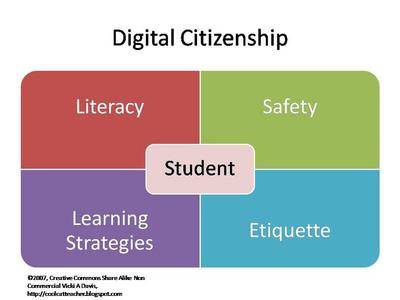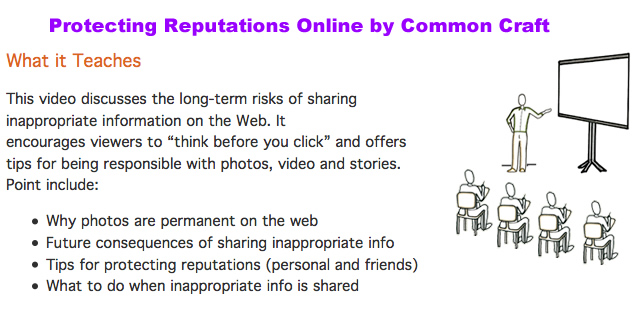Digital Citizenship
What is Digital Citizenship and why is it important?
 According to digitalcitizenship.net, "Digital Citizenship is a concept which helps teachers, technology leaders and parents to understand what students/children/technology users should know to use technology appropriately. Digital Citizenship is more than just a teaching tool; it is a way to prepare students/technology users for a society full of technology. Too often we are seeing students as well as adults misusing and abusing technology but not sure what to do. The issue is more than what the users do not know but what is considered appropriate technology usage. "
According to digitalcitizenship.net, "Digital Citizenship is a concept which helps teachers, technology leaders and parents to understand what students/children/technology users should know to use technology appropriately. Digital Citizenship is more than just a teaching tool; it is a way to prepare students/technology users for a society full of technology. Too often we are seeing students as well as adults misusing and abusing technology but not sure what to do. The issue is more than what the users do not know but what is considered appropriate technology usage. "
Today and in the future our wired world presents new opportunities with open access to technology. Along with the opportunities come pitfalls especially to those who are unaware of the hidden dangers. In the past kids could do things that could easily be laughed at and forgotten. Today, however, with ubiquitous posting of information, photos and video, everything is recorded and can be remembered. In a July 19, 2010 New York Tomes article, The Web Means the End of Forgetting, Jeffrey Rosen talks about how. web sites with "embarrassing personal revelations... ill-advised photos and online chatter ...are coming back to haunt people months or years after the fact. "
According to a recent survey 75% of recruiters do online research about candidates, and they often reject candidates based on what they find online. Rosen talks about how in the past we all could reinvent ourselves but how today the so called "self-made man" is endangered by his online record. As adults we must be concerned about our digital reputations, and it is imperative that young people learn and understand digital literacy and safety.
In a Nov 28, 2010 Physorg.com article "Google-an Engine of Knowledge Creation?" discusses the work of Jose van Dijick of the University of Amsterdam who questions the use of search engines like Google for academic research. He says that commercial search engines tap into public values and don't always have transparency and openness like traditional library scholarship. Internet users tend to treat commercial search engine results as neutral. "To ensure future generations of critical and knowledgeable scholars, we need to teach information literacy enriched with analytical skills and critical judgement. The production of scientific knowledge is way too important to leave to companies and intelligent machines," says van Dijck.
In 2008, Illinois Public Act 095-0869 amended the school code to require Internet Safety. It requires that a component of internet safety be taught every year from grade 3 and above. Topics covered include safe and responsible use of social networking, online solicitation, transmitting personal information, deceptive communications, harassment and cyberbullying. illegal activities and copyright laws. Below are considered the norms of appropriate behaviour with regard to technology use.
9 Elements of Digital Citizenship
(From digitalcitizenship.net)
Digital Etiquette: electronic standards of conduct or procedure.
Distinguishing inappropriate from appropriate behavior when we see it, but before people use technology they do not learn digital etiquette (i.e., appropriate conduct).See a video on Netiquette here
2. Digital Communication: electronic exchange of information.
Today everyone can communicate and collaborate with anyone from anywhere and anytime. However, some users do not understand the implications of their decisions when faced with so many different digital communication options.
3. Digital Literacy: process of teaching and learning about technology and the use of technology.
The future requires a focus on what technologies must be taught and how these technologies should be used. Learners must be taught how to learn in a digital society anytime, anywhere and as new technologies emerge, learners need to adapt quickly and appropriately. Information literacy skills are key to Digital Citizenship
4. Digital Access: full electronic participation in society.
Everyone needs to have fair access to technology in communities for Digital Citizenship and to enhance growth.
5. Digital Commerce: electronic buying and selling of goods.
Access to technology 24/7 means that users need to learn to be responsible consumers online. Users must distinguish legal from illegal online activities, legitimate sites versus illegitimate sites.
6. Digital Law: electronic responsibility for actions and deeds Copyright and Fair Use
Digital citizens need to understand law and ethics of technology within society, distinguish between theft and sharing, and understand copyright and fair use.
7. Digital Rights & Responsibilities: those freedoms extended to everyone in a digital world.
Digital citizens have the right to privacy, free speech, etc. but as well as right there are responsibilities.
8. Digital Health & Wellness: physical and psychological well-being in a digital technology world.
Users must understand physical and psychological issues and dangers of technology. Digital Citizenship includes a culture where technology users are taught how to protect themselves through education and training.
9. Digital Security (self-protection): electronic precautions to guarantee safety.
Users must learn how to protect themselves online through virus protection, backups of data, and surge control of our equipment. ( source http://www.digitalcitizenship.net/Nine_Elements.html)
For an excellent video aimed at young inexperienced internet users on Protecting Reputations online see Common Craft's Video See the video Here

Teaching Copyright
 With the rise of social networking and a culture of sharing, it is important for teachers and students to learn about the legal uses of materials. Some may want to fight for more openness to improve creativity, while others may want to fight for more restriction to protect and preserve authors' works. Debating copyright in class can provide students an opportunity to understand the positions involved and internalize the concepts. There are many open resources to aid in the teaching of copyright.
With the rise of social networking and a culture of sharing, it is important for teachers and students to learn about the legal uses of materials. Some may want to fight for more openness to improve creativity, while others may want to fight for more restriction to protect and preserve authors' works. Debating copyright in class can provide students an opportunity to understand the positions involved and internalize the concepts. There are many open resources to aid in the teaching of copyright.
For information about teaching copyright see any of the following:
- Teaching Copyright http://www.teachingcopyright.org/ a project of the Electronic Frontier Foundation"Teaching Copyright provides lessons and ideas for opening your classroom up to discussion, letting your students express their ideas and concerns, and then guiding your students toward an understanding of the boundaries of copyright law."
- The Digital Learning Challenge: Obstacles to Educational Uses of Copyrighted Material in the Digital Age A Foundational White Paper
- Doctorow, C. (June 29, 2010). Copyright best practices for communications scholars, BoingBoing. (From an original post on Cost of Free by K. Hamilton)
What is Fair Use?
Fair use, according to Stanford Law, is the use or copying of copyrighted material for limited and "transformative" purpose. For example, a person could comment on, criticize or parody a copyrighted work. These uses do not require permission from the copyright owner. Fair use is not an infringement of copyright. The problem of determining what is fair use is caused by the wording of the definition. The word "transformative" is open to interpretation. Millions of dollars in legal fees are spent every year to determine what is and is not fair use.
Most fair use fits under either criticism or parody:
Comment and Criticism
Fair use principles allow users to reproduce some of the work for comment or criticism.
Some examples of commentary include:
- quoting a few lines from a song in a music review
- summarizing and quoting from an article on a specific subject in a news report
- copying a few paragraphs from a news article for use by a teacher or student in a lesson, or
- copying a portion of a magazine article for use in a related court case.
Parody
Parody is a work that uses humour and imitation to make fun of, usually well-known work. Parody by its nature requires using some of the original work. In parody a fairly large part of the original work is permitted. (Stanford, Chapter 9)
To learn more about fair use see Six Resources for Learning about Fair Use
For information about fair use in scholarly research see Code of best practices in fair use for scholarly research in communications (2010), Center for Social Media or download the Code of Best Practices in in Fair Use for Scholarly Research in Communication PDF here
According to Sarah Perez in her July 26, 2010 article "Fair Use Legalized, Says EFF" new exemptions have been included in the Digital Millennium Copyright Act.
From the article:
"Exemptions include the following:
- Permission for cell phone owners to break access controls on their phones in order to switch wireless carriers or "jailbreak" their device
- Permission to break technical protections on video games to investigate or correct security flaws
- Permission for college professors, film students and documentary filmmakers to break copy-protection measures on DVDs so they can embed clips for educational purposes, criticism, commentary and noncommercial videos
- Permission to enable an e-book's read-aloud function or use a screen reader with the e-book, even when built-in access controls prevent this
- Permission for computer owners to bypass the need for external security devices called dongles if the dongle no longer works and cannot be replaced" (Read Write Web article)
- Point 3 sounds like a welcome addition!
Watch Fair Use in Action
The video, A Fair(y) Use Tale, uses Disney characters to humorously explain copyright. The use of Disney characters is ironic, as Disney has been a vocal opponent of openness and their history contains much appropriation of previous culture without attribution. The character Mickey Mouse who first appeared in 1928 in "SteamBoat Willy" was a direct take-off of Buster Keaton's, "Steamboat Bill" from earlier in the same year and a great many of their characters come from the Brothers Grimm.
The video "A Fair(y) Use Tale" comes out of Stanford University’s Fair Use Project that supports projects that clarify, and extend, the boundaries of fair use and enhance creative freedom. According to Mat Honan of Wired, "The mashup cuts up and splices audio from more Disney movies than I could begin to list (or even identify) to explain the intricacies of copyright law and the fair use doctrine. It takes the works of “the very folks we can thank for nearly endless copyright terms” and flips them to argue against longer copyrights and attacks on fair use. It leads to some beautifully surreal moments, often highly recursive, with the characters of The Jungle Book and The Lion King asking questions such as 'what is the public domain?' or proclaiming 'fair Use is not a right; fair use is only a legally defensible position, and this is not fair…The point is if fair use actually works then movies like this one will have legal protection.' Word." (Honan, 2007)
(From an original post on Cost of Free by K. Hamilton)
To provoke an interesting conversation about copyright, remixing and mashing, teachers could show the documentary
RIP: A Remix Manifesto 2.0 (see Open Source Cinema. http://www.opensourcecinema.org/project/rip2.0) or portions of it in class.
Next up, Sustaining the Vision
